
Snaking sinuously south from just west of Santander there's a savage slit that acts as the border between Cantabria and Asturias and the main thoroughfares into the heart of the Picos de Europa. Deep, steep-sided and improbably festooned with a ton of amazing looking faces (not all of them developed) the gorge of the Desfiladero de La Hermida combines perfectly with the crags around Arenas de Cabrales in eastern Asturias to make a brilliant, easy-access, summer and autumn sport climbing destination.

Around 20 crags, including some only very recently opened, all in the shadow of Picu Urriellu (Naranjo de Bulnes), combine to give a variety of options: long, short, steep, slabby, walls, tufas and more, that should delight almost any grade of climber. Add in easy access, the proximity to brilliant beaches and plenty of accommodation and it's easy to see why the region's becoming more and more popular.


El Desfiladero de La Hermida / The Gorge of La Hermida
Around 45 minutes drive from Santander, or half an hour from the huge beachside campsite at San Vicente de La Barquera, this is, even for non-climbers a spectacular valley. But, driving down it as a climber it's almost impossible not to get neck-ache straining to see up the steep, green slopes and take in the sheer quantity of cliffs that seem both accessible and climbable…
Usefully, the valley is compact and simple to navigate. The crags in the guide are often roadside, and all within about 10km of each other. A big plus here is that switching venues during the day, to swap styles, grades or chase sun or shade, is a viable and popular option. The only real downside to this compact and impressive terrain is that the valley is one of the biggest tourist attractions in the Picos and in the height of summer the traffic is heavy and parking can be difficult. But out of these 8 weeks in July and August there is really no issue and overall it is a great place to climb and has some really good crags.
Top tip – due to 'political issues' I have not been able to include all the crags in this amazing valley (watch this space though) but in the bar La Cuadrona at La Hermida or in La Reunion in Potes there are folders with topos for some of the more 'secret' spots…
Rumenes
An amazing venue and a contender for the best 'tufa' climbing in Asturias. The walls and routes at Rumenes are simply phenomenal and amply demonstrate the potential in this valley. The upper crag for the most part is literally tufa-strewn and provides a series of long, stamina testpieces. The rock is generally very high quality limestone and although, it's worth climbing gently as with all tufa routes, there are no significant problems. Perhaps the only downside is that there are very few easy routes here, though the easier pitches that do exist - slabbier routes on Principiantes as well as Espolón, are actually very good. The lower crag is much shorter and may seem insignificant in comparison but the routes are worthwhile and pack a punch.
El Infierno
Rivalling Rumenes in the tufa stakes El Infierno is worth a visit for anyone climbing in the mid-sevens that loves wrestling limestone. This is another fantastic sector with an abundance of tufas which make for brilliant routes. A bit like a supercharged Rumenes, there are very good mid-grade 7s but there's also plenty at the top-end to get excited about. The rock is very good and the tufas seem very solid as well. Recently opened, the bolting is good though there is the odd run-out. A very good crag for those operating in the higher grades and perhaps the only downside is that there are few easy routes.

Urdón
Situated next to the road, almost straddling the border of Asturias and Cantabria, this is a good, small crag with a selection of routes across the grades. Comprised of two distinctly different sectors - one essentially a big cave, the other a gently overhanging wall, there's a wide variety of climbing styles. So from delicate slabs to burly tufas and pumpy wall climbs, all on very good quality limestone, there's plenty to go at and there should be something for everyone here. Route length varies and at the base of the cave there are plenty of shorter routes. However, there are 25-metre-plus pitches to have a go at and the variety at Urdón is partly what impresses. A very popular spot, some of the easier routes are a bit polished now and this is possibly due to the fact that the lower sector is climbable in light rain.

El Salmón
Somehow an ugly crag but one I return to often, though I am running out of routes, as the climbing is very good. There's a wider spread of grades here with many of the best routes between mid 6s and mid 7s. An easy-access venue with some very good routes, especially in the mid to upper 6 grades, and a variety to the climbing that makes for an excellent day out. Short, steep, tufa routes that pack a punch sit next to longer, more intricate pitches that provide food for thought. The lower crag has very few routes for its size and is quite an intimidating venue, but the few routes there are make for some very good pitches and are as exciting as they look. The rock is generally very good quality and varies between tufa-covered and solid, blocky, less attractive sections and some compact grey limestone.
Placas de Esquilleu
This recently opened venue is a compact, high-quality slab that is perfect for beginners – but can still give an exciting moment or two to more experienced climbers. At first glance it may seem a bit underwhelming (and if you're a Rumenes tufa-fanatic it probably is) but it's actually great fun and the routes are a decent length on superb grey rock. At the time of writing, although very popular, the routes still have plenty of friction. It has the added advantage in summer of getting into the shade in early afternoon.
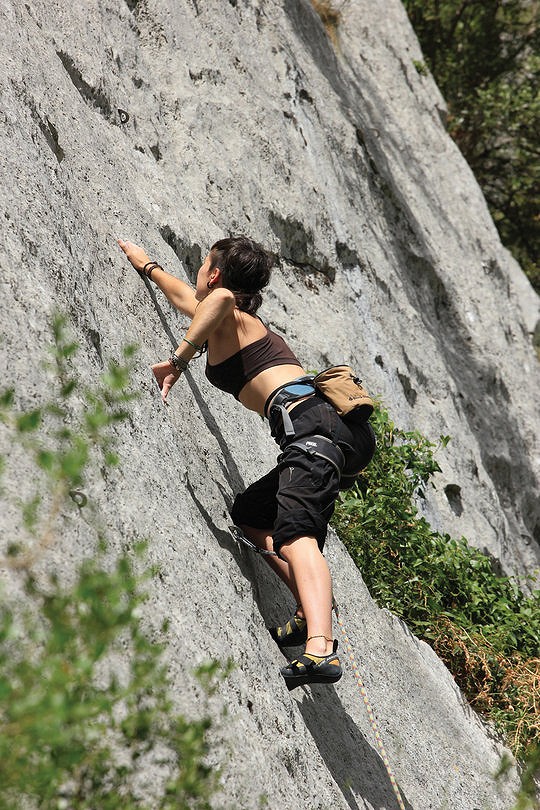
Around Arenas – eastern Asturias
Running at right angles to the Desfiladero – just go west in Panes instead of heading south – a second steep gorge opens out at Arenas de Cabrales to a broader, less extreme landscape. It's only a short drive from La Hermida and the mountains are still only a heartbeat away, but at Arenas there's an oasis of flattish fields and a less hemmed in feel. This popular holiday town is at the 'neck' of one of the ways into the Picos and makes a great base with its large campground-busy feel and plentiful bars and restaurants.
For sport climbers in Arenas the main draw has always been Poo de Cabrales, but without detracting from the quality of the routes there, it's actually a bit of a god-send in that in recent years there's been a relative glut of new venues to play on fairly close by. The new crags of Berodia, Caldueno and Cabeza Alta offer significantly more choice and loads of generally good new routes. And with both Caldueno and Cabeza Alta set in a tranquil valley running parallel just a few kilometres north it's easy to recommend losing yourself there for a day (with the proviso that both have bird restrictions until August). Finally, it's great to be able to include possibly the most chilled crag in Asturias, Cuevas del Mar which, sat on a perfect beach and 75 metres from a bar makes a sunny day whizz by!!

Poo de Cabrales
One the most well-known Asturian crags due to its proximity to Arenas and the quality of the rock this is a very, very good venue. Poo not only has a good number of high quality routes but there's a fantastic variety too, from slabs to walls to tufas, making this a justifiably popular venue. Not only that, it's climbable year round and occupies an incredible situation on the edge of the Picos with Naranjo De Bulnes as a backdrop. The only downside is that there are few easy (5s and low 6s) routes and it's best to be climbing in the mid to high 6s to make the most of it. The crag breaks down into approximately five main sectors, divided between an upper and lower crag, with the majority of routes between 15 and 25 metres. The rock is very good quality limestone and very well equipped.
Berodia
Just up the road from Poo and a very worthwhile new addition to the area, Berodia is already established as a popular spot. Situated close to Las Arenas it's quick drying and has a very 'user-friendly' feel. There's a short approach and quite a few good easy routes for beginners. There are also plenty of mid-grade and good harder routes too making this a good all-round venue for a mixed-ability group. The rock is generally very good and the bolting is new.
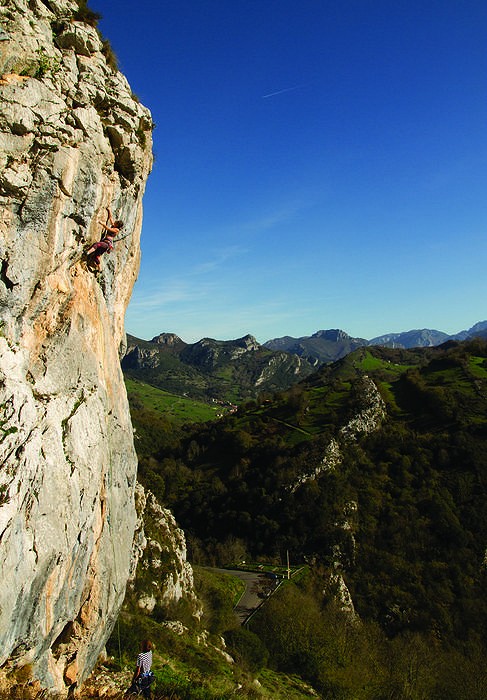
Cabeza Alta and Caldueño
These crags are situated in the gorgeous valley locally known as Mazuco – this runs parallel to the valley with Arenas in yet is a pinch nearer the coast.
Caldueño - Recently overhauled, though opened a long time ago, Caldueño is a good all-round venue with perhaps the highlight being a bunch of long slab routes. One attraction here is that there's some shade across the day so you can move between sectors to make the most of the conditions. Aviados and Pared del Sol are very accessible though the approach is steep, while the sectors set higher in a big gully are a bit of a hike. However, there are enough decent routes to make the extra ten minutes worth it. The rock is generally very good but it's worth noting that on Dos Setas it feels a bit suspect in places. Overall the bolting and belays are very good too with the odd exception. The crag needs traffic but once clean offers good climbing. Bird Ban 1st March until 31st July
Cabeza Alta - Very recently opened, this is a very good addition to the area; a proud chunk of rock in a priviledged position with a good haul of routes. The rock is very good, a mix of grey and orange limestone with plenty of friction, and there is a wide selection of grades. Mainly slab and wall climbing with the odd steep bit thrown in, it's a great place for a mixed ability group. As it is so new the routes will need a bit of traffic to make sure they are 100% clean and it's also worth noting that it will be shut for 5 months. Many of the belays are rings so remember to take a couple of draws. A 70m rope is useful too. Still under development there's a good chance there will be more lines than appear in my book . PS the bar in the village is spot on!!!! Bird Ban 1st March until 31st July
Cuevas del Mar
A great little venue with one of the best locations in Asturias. The routes are generally on the short side but there is quite a bit to go at, from steep to slabby, as well as a good spread of grades. This is a very popular crag and can be very busy in summer. It's also in the process of being overhauled and re-bolted with stainless bolts and glue-ins. Climbing, swimming and a bar on the beach...can it get any better?
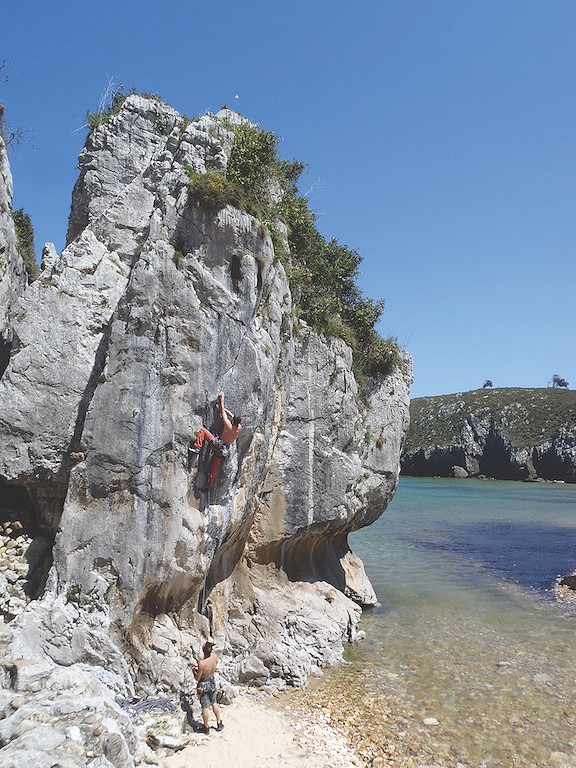
Summary
These valleys make a great climbing location and have a mix of world class with some more moderate crags. For the serious climber there's plenty to go at while for the less committed their location and ambience is second to none; and the fact you can make a summer holiday out of it and be at the beach in about 45 minutes from any of them is highly recommendable.
There's also the big draw of being able to mix up some big days out in the Picos with some less serious cragging.
When to Go
Like most of Asturias, Spring is probably the least stable time and for tufa climbing especially up until May nothing is 100% guaranteed to be dry. I would suggest for this area mid-May to December is the best time. And if you want to combine it with trips into the Picos for high mountain stuff then probably June onwards to get reasonable temperatures at a height. We went up Naranjo in late May once and froze our combined bits off!
How to Get There
Santander is the obvious point of arrival with ferries arriving from Portsmouth every other day, while Ryanair fly from Edinburgh as well as Stansted. However, Bilbao is not far, about 1 hour's drive and again there are both ferries and flights by Ryanair and Easyjet. Finally because the roads are so good, and so empty, you can even fly to Asturias airport from Stansted and it's only 90 minutes along the motorway to Llanes or thereabouts.
Accommodation Advertise here
No Premier Listings found in this area
In La Hermida – There is no campground apart from a long way up in Fuente De (right at the southern end of the valley). This means it's about equidistant from La Hermida as the one in Arenas – about 45mins for each meaning neither is exactly perfect. However, there is wild camping at a spot on the opposite side of the river to the parking for El Infierno – just be careful taking anything bigger than a car over. Vans are OK in the valley but in high season be aware that outside of the approved spots in big vans you can get fined – just south of La Hermida is an approved parking. Again outside of these times there is generally no problem. Smaller vans, VW size are OK nearly everywhere.
The valleys are very tourist focussed though Bar La Cuadrona is very climber friendly and has great rooms and plenty of topos…and a friend of mine owns La Reunion bar in Potes, brews his own superb beer and has even more topos.
Around Arenas there are tons of apartments and hotels as well as a huge campsite that's open for a good part of the year. This is a great spot campingnaranjodebulnes.com. There are more campsites next to quite a few of the most popular beaches a little further north in Llanes and San Vicente de la Barquera www.campingelrosal.com And it's actually not far from any of these spots to get a quick hit in if you are with a family or want to mix it up with some surf/climbing.
Outdoor Shops Advertise here
No Premier Listings found in this area
Instructor/Guides Advertise here
No Premier Listings found in this area
Top Tips
In La Hermida the worst kept secret are the hot springs which bubble up under the bridge over to the Balaenario a little south of the main town. Caught in little pools the volcanically heated water gives the body a once over and then a quick plunge in the middle of the river gives it a flush. However, my advice would be that these are rammed at night so a sneaky morning visit gives you this almost totally empty…just watch your skin on the tufas afterwards!
If you are going into the Picos one word of warning is that it's big. Bigger than it looks. So be aware and treat these mountains with respect. Oh and also take your passport if you're going to the refugio or you won't get in!! And in August it's defo worth booking a spot…
The beaches are stunning and endless. San Vicente is one of my favorites and is about 2km of sand and has a pretty good surf on its day.
Then I have to recommend the food. These are regions with a ton of fantastic food: Cantabria has brilliant cheeses including the amazing Bejes, matured in caves very close to the crags of La Hermida; while in Asturias there's the famous bean stew, Fabada and of course the legendary cider; poured from a height it's a cultural rite of passage for any visitor.
Watch a video of James Pearson and Caroline Ciavaldini climbing in the area.
About Richie Patterson – Ex-pat Richie has lived in Asturias for 11 years and wrote the very successful Roca Verde guide – to which he's just printed a second edition. He's trying to climb as much as possible whilst hoping to publish more guides and run his rental house is the western part of the Roca Verde territories www.casquiros.co.uk.
- Read Ben Masterson's review of the new Roca Verde guide here
- Rock Rags - Home of Betamonkeys clothing and more... 26 Nov, 2015
- DESTINATION GUIDE: Valles de Trubia 9 Mar, 2015

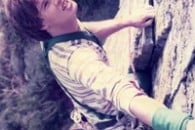







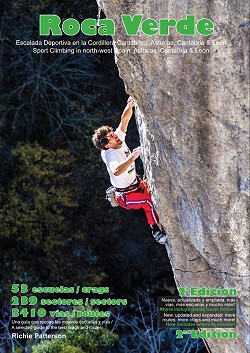



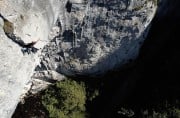

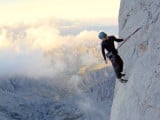


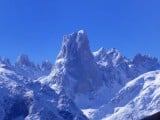








Comments